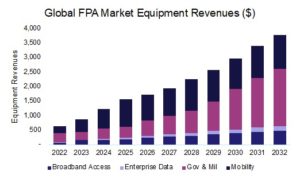Are the USPs of FPAs more than just price?
The adoption of flat panel antennas (FPAs) has surged in recent years, driven by their compact design, adaptability to various applications, and their capability to provide reliable on-the-move communication. Advancements in technology have enhanced their performance, including beamforming capabilities that allow them to maintain a strong connection while on the move. According to NSR’s latest Flat Panel Satellite Antennas report, the global FPA equipment revenues will grow at a CAGR of 19.2% from USD 650 million to almost USD 4 billion in 2032.

The FPA stumbling block
While FPAs come bearing good news, there are a few factors that threaten their adoption and hence have slowed market performance in the last few years; Cost considerations, the complexity of technology deployment, the need for regulatory compliance, and challenges associated with standardization efforts. While cheap antennas may seem like a cost-effective solution, their low price often comes at the expense of performance and reliability but higher-quality antennas, though more expensive, typically offer better performance, longer lifespan, and enhanced resilience to environmental challenges.
Flat panel antennas have long been anticipated to revolutionise the COTM (comms-on-the-move market). However, no one seems to have totally cracked it. The slow adoption of flat panel antennas has hindered their market performance by limiting their penetration into various industries and applications. This sluggish uptake has restrained revenue growth and market expansion, delaying the realization of economies of scale that could potentially drive down production costs and increase affordability.
USPs manufacturers should focus on
Manufacturers should emphasize COTM connectivity. The ability of FPAs to establish and maintain reliable communication links while in motion, provides a crucial advantage for COTM applications such as military convoys, first responder vehicles, and maritime vessels.
As the FPA market pivots towards low-pricing vs. quality and value-driven products, it underscores the evolving priorities in the FPA industry. Enterprise end-users are recognizing the importance of quality and performance over cost savings. With the growing demand for high-speed data and low-latency applications, consumers are increasingly willing to invest in premium FPAs that offer improved reliability and better signal performance.
Manufacturers should also improve global network compatibility by ensuring that antennas are compatible with multiple satellite networks. They should focus on providing global connectivity options, with various satellite constellations and are not limited to a single provider, providing users with flexibility and choice. Kymeta already launched its Multi-Orbit, On-the-Move Flat-Panel Antenna for Military Users, the Osprey u8 HGL. Global network compatibility facilitates interoperability and reduces fragmentation in the satellite communication ecosystem.
The Bottom Line
Flat panel antennas are gaining traction in the satcom industry and as competition in the FPA market intensifies, manufacturers are focusing on innovations that enhance efficiency, minimize form factor, and provide superior value for customers, rather than simply competing on price. New architectures that leverage overlapping interests and investments of government and commercial markets, may prove to be the key to unlocking the full potential of FPA-based satellite communications, significantly accelerating its growth.
